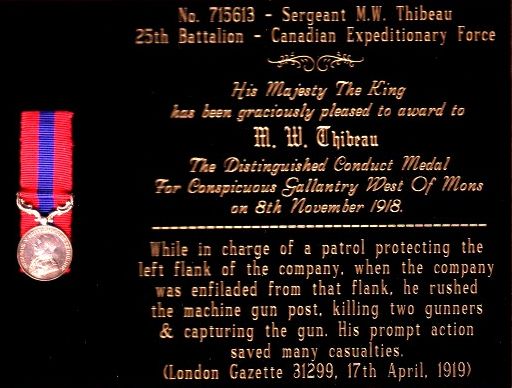

IN MEMORy by Pierre Vandervelden
The visit of Commonwealth graves in Communals Cemeteries & Churchyards in Belgium & France
RIVER BOURGEOIS Roll of Honour (Nova Scotia CANADA)
By Don POTTIE
Page 1 The Cenotaph, Homage to Our Boys.
Page 2 Moses William Thibeau, Local Hero.
 |
| Moses William Thibeau was born March 26, 1890, the oldest of six
children born to Peter Thibeau (1858-1931) & Catherine Fougere (1867-1960).
Willie appears in the 1901 & 1911 Census. In the latter he was recorded
as a labourer, the same occupation he had when he enlisted in January of
1916 in Truro with the 106th Battalion, the Nova Scotia Rifles . After a
brief bout with tonsillitis in May, Willie and his unit sailed overseas
from Halifax on the SS Empress of Britain on July 15, 1916 arriving in Liverpool
ten days later. The 106th Battalion never fought as a unit as the men were
used as reinforcements for the 25th and 26th Battalions. Although most of
the men were transferred to the 25th, including Willie’s friend Moses
Cordeau with whom he had enlisted, for some reason Willie ended up in the
26th Battalion better known as the “New Brunswick’s Fighting
26th.” Willie arrived in France on September 28th, 1916 and joined the 26th Battalion just after the battle of Courcelette, one of the main battles of the Somme offensive. Over the next year little is known of his whereabouts. It can be presumed that he fought with the 26th in various engagements including Vimy Ridge, Lens and Hill 70. It was during the last of these engagements that he was promoted to Corporal on August 15th, 1917. During a lull in the action following Hill 70, Willie went on a course (Lewis Gun) on August 28th and rejoined his unit on Sept 8th in time for the battle of Passchendaele (November 3rd-7th, 1917). He took leave from November 24th to December 8th, during which time Canadian soldiers in the field voted in the Federal election. Fighting was light during the winter months until the Germans began their spring offensive. The 26th did not participate in any major engagements until the summer of 1918 when, the Allies began their counter offensive that would eventually end the war. The 26th participated in the battles of Amiens (August 1st-17th) and Arras (August 25th-29th). It was during this latter engagement that Willie was wounded slightly in the left arm. He rejoined his unit on September 22nd after being promoted to Lance Sergeant. He probably participated in the Canal du Nord battle around that time (September 19th-25th). He was on a course (Musketry School) from October 7th to November 3rd and did not participate in the battle of Cambrai (October 8th-11th). By the time he returned the enemy was falling back across the front and the action was very fluid. The 26th was once again in the thick of the advance in the last week of the war when Willie performed with such bravery that he was awarded the Distinguished Conduct Medal. “For conspicuous gallantry west of Mons on 8th November, 1918, in charge of a patrol protecting the left flank of the company. When the company was enfiladed from that flank, he rushed the machine gun post, killing two gunners and capturing the gun. His prompt action saved many casualties.” After the war ended on November 11th, it took some months for the troops to return to Canada. It was during this time that Willie took sick and was in hospital when the 26th Battalion left England on May 10th, 1919. Willie remained in hospital and did not return until August. Little is known of his whereabouts after he returned. My mother recalled a story of him carrying her on his shoulders while tending his rabbit snares one winter. She was very young at the time (perhaps about 4 years old). It is not known exactly when Willie left to work on the Welland Canal but his accidental death after falling from a great height on May 29th, 1922 was recorded in the Toronto newspaper. He had just turned 32 in March. |
| A copy of the form Willie completed upon enlistment (Attestation Paper)
can be found at this location: http://data2.archives.ca/cef/gpc016/631809a.gif
The military file containing additional information regarding his whereabouts
during his period of service can be obtained at: Library and Archives Canada
RG 150, Accession 1992-93/166, Box 9592 – 66. Much of the personal
information that follows comes from this file. Much of the information that follows about the unit in which he served comes from, MacGowan, S. Douglas, New Brunswick’s “Figthing 26th”: a history of the 26th New Brunswick Battalion., 1914-1919. Saint John, N.B., Neptune Publishing Co., 1994. |
| The final note on his military file shows a letter from his father Peter Thibeau requesting a military headstone after his death in 1922. The military responded that since his death was not a result of the war they could not pay for a headstone. Paul Touesnard |
 |
| Text and top photo are Copyright of Moses's nephew Paul Touesnard, Don thanks him for his permission to use them. |
Casualties informations come usualy from Commonwealth War Graves Commission, see links for more informations
Inmemories.com © Pierre Vandervelden - Belgium